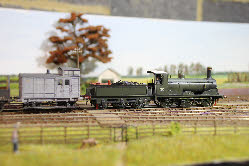



Last updated May 2019
Stroudley C class 0-6-0 no 405 goods tender engine
Stroudley C1 class 0-6-0 no 427 goods tender engine
Billinton C2 class 0-6-0 no 522 goods tender engine
Marsh C3 class 0-6-0 no 309 goods tender engine
 The C-
The C-class 0-6-0 goods engines were Stroudley’s first ‘all new’ designs for the Brighton, the earlier Belgravia class having utilised frames ordered by his predecessor John Craven. The first two entered traffic in December 1871 as nos 84 and 85. Following a series of trials in 1872, and various modifications, a further 12 of these engines were ordered from Kitsons. These were much delayed, with the last eventually arriving at Brighton in 1874. In the meantime, a further six of the class were built at Brighton, entering traffic in 1873, giving a class total of 20 engines. Originally numbered 77 to 96, all were renumbered between 1880 and 1893 to 401 to 420. The photo (right) shows number 405 in a very sorry state, awaiting scrapping in 1902. This loco was shedded in Newhaven at the turn of the century, and would have been frequently seen running through Plumpton with the Newhaven - Willow Walk goods.
Our model is of no 405, built at Brighton Works, in its 1872 modified version, with Salter’s safety valves, no steam brake, and a low-sided outside frame tender. It is an EB Models kit.
 The first photo shows the loco coupled to its tender for the first time, awaiting the last few fittings to be added.
The first photo shows the loco coupled to its tender for the first time, awaiting the last few fittings to be added.
I don’t personally like the idea of annealing brass to enable curves to be formed - it’s a bit hit-and-miss. If you don’t heat it evenly, it won’t easily form an even curve, and if it’s heated too much it will end up quite soft, and liable to damage if slightly roughly handled (as I know from experience). Many years ago there was a sheet metal works in Horsham who were quite happy to sell relatively small quantities of brass and nickel silver sheet. I paid £25 (their minimum order, and quite a lot of money in 1978) for some 2, 5, 10 and 18 thou nickel silver. It turns out I bought a lifetime’s supply!
For this engine, and also the C1, I used the original brass boiler as a template, and cut a new one from 5 thou nickel silver, and rolled it to shape in my rolling mill - no annealing needed. Nickel-silver also has the advantage that it doesn’t conduct heat very well (unlike brass) and is therefore much easier to solder. (This makes me wonder why kit manufacturers don’t use n-s instead of brass? I appreciate it’s more expensive, but how much would it add to the overall cost of a kit? It would make the whole experience of building etched kits a pleasure instead of a chore!).
I also took the opportunity of replacing the two-part tender sides with a single piece of 10th n-s, to avoid the soldered seam at the rear of the tender body. I’ve also added the washout plugs (not included in the kit) which feature on some of these engines - another little 3D printing project.
I started this kit in late 2017, but while I’ve been building it, we’ve also been building a C1, and two part-finished Terriers (Stepney and Martello), so it’s taken quite a long time. However, by August 2018 it’s complete and ‘in service’.
A couple of photos of its first run with a goods train.


Stroudley C class 0-
Billinton C2 class 0-
Marsh C3 class 0-
 The C-
The C-Our model is of no 405, built at Brighton Works, in its 1872 modified version, with Salter’s safety valves, no steam brake, and a low-
 The first photo shows the loco coupled to its tender for the first time, awaiting the last few fittings to be added.
The first photo shows the loco coupled to its tender for the first time, awaiting the last few fittings to be added.I don’t personally like the idea of annealing brass to enable curves to be formed -
For this engine, and also the C1, I used the original brass boiler as a template, and cut a new one from 5 thou nickel silver, and rolled it to shape in my rolling mill -
I also took the opportunity of replacing the two-
I started this kit in late 2017, but while I’ve been building it, we’ve also been building a C1, and two part-
A couple of photos of its first run with a goods train.

